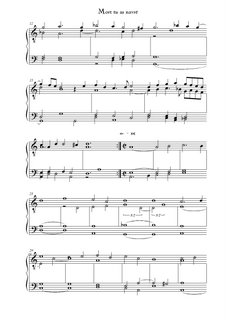 The piece is in two sections, the first in a triple division, the second, duple*, with contrasting tempi and densities. Ockeghem connects the two sections with a modest move, allowing the next-to-highest voice (contratenor altus) to change its tempus, first singing a division of three against the prevailing two, and then two dotted notes against three undotted in the other voices. This happen once only and then all four voices continue in the duple tempus to the end. That one triplet, and the following duplet add, at low levels of subdivision, a bit of breath into the second part, both connecting back to the tempus of the first section while introducing, perhaps, some ambiguity about how things will continue. At this low level, it is not the gesture of a slick musician articulating in-your-face polyrhythms with aggressive precision but rather a relaxed, almost rubato, gesture, and one which makes a whole out of the contrasting sections.
The piece is in two sections, the first in a triple division, the second, duple*, with contrasting tempi and densities. Ockeghem connects the two sections with a modest move, allowing the next-to-highest voice (contratenor altus) to change its tempus, first singing a division of three against the prevailing two, and then two dotted notes against three undotted in the other voices. This happen once only and then all four voices continue in the duple tempus to the end. That one triplet, and the following duplet add, at low levels of subdivision, a bit of breath into the second part, both connecting back to the tempus of the first section while introducing, perhaps, some ambiguity about how things will continue. At this low level, it is not the gesture of a slick musician articulating in-your-face polyrhythms with aggressive precision but rather a relaxed, almost rubato, gesture, and one which makes a whole out of the contrasting sections.And then this: Ockeghem's modern editors, Wexler and Plamenac, suggest that the text underlaying the contratenor altus here is in cruce.
_____
* There is considerable debate about how such a transition is to be realized; most current scholars and performers appear to prefer a sesquitertia (4:3) relationship between the two tempi, with a common long duration divided into three parts in the first section, and four in the second. I find the sequitertia solution very convincing, however, a connection between the two parts is also vivid when note values have a constant duration. Note values in the example are halved.
No comments:
Post a Comment